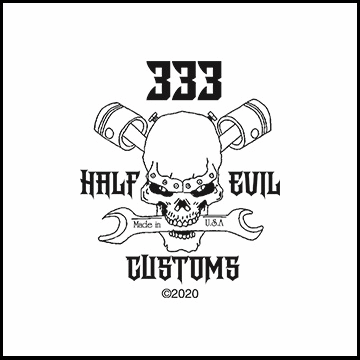Cleaning Motorcycle Electrics
Get some of the De-Oxit electrical contact cleaner and figure on spending a good day going from the front of the bike to the back. It’s a plastic safe cleaner/preservative.
www.deoxit.com is their website.
On the older Kawasaki's, a majority of electrical connectors are inside the headlight housing requiring removal of the headlight, then the fun begins.
Do one set of electrical connectors at a time to avoid mixing up what connects to where. Usually disconnecting, spraying with De-Oxit and reconnecting is about all you'll need.
However, when encountering the green crud of corrosion, a brass wire brush may be needed on the pins you can reach.
Some 400-600 grit wet and dry sandpaper strips rolled into a tube should reach the male and female pins in the more difficult to clean connectors.
Smoker’s pipe cleaners, cotton swabs and wooden toothpicks work as cleaning aids.
Really small electrical connectors may require the use of a welders tip cleaning tool assortment.
Most pins in the connectors are coated with a thin plating of tin, and others may be nothing more than copper or brass.
If moisture is added, the resulting corrosion lowers the voltage/current being carried causing dim lights, slow engine cranking, slow turn signal response and lower input voltage to the ignition coils resulting in weak spark.
The left and right handlebar switch pods will need attention too as they have circuit functions like turn, horn, run/stop, and start.
Usually a spritz or two with actuation of the switch is about all needed for these switches unless corrosion is detected and then careful disassembly is required.
The ignition switch may or may be not sealed to allow spraying the internal contacts. I urge caution if attempting to open this up as springs, and ball bearings may fly out never to be seen again!
If your bike has the older style glass tubed fuses, I suggest replacing them as vibration can cause internal failure. AGX is the type used, and most auto parts stores can get them for you.
Clean the fuse holder clips, looking for signs of overheating(discolored insulation, signs of melting).
I use metal polish on a cotton swab, followed by spraying another clean swab with the De-Oxit and then rubbing the inside of the fuse clip.
All battery cables must be clean and tight for maximum current transfer. Check the cables going from the Negative(-) battery terminal/post to the engine mounting bolt
Also the one going from the Positive(+) terminal to the starter solenoid and from there to the starter motor.
If any battery cable feels ”Crunchy” when flexed, replace it as possible corrosion is inside the insulation.
Each "Bullet Connector" will have to be sprayed to ensure good connectivity, especially the ones going to the energizing coil of the starter solenoid.
The alternator output “Bullet Connectors” are usually behind the engine sprocket cover and will need inspecting and cleaning too.
The turn signal light sockets will benefit from a spritz from the contact cleaner along with the tail light/brake light socket.
Some brake light switches can be sprayed on the actuating rod, with the spray running down inside to the electrical contacts, others may be sealed requiring replacement if the switch is intermittent in operation.
Some people put the Di-Electric Grease on cleaned terminations/connectors, I don’t, as I’ve read/heard it can cause problems when it gets hot, actually insulating the connections, so the choice is yours to use or not.
Using WD-40?
Bad idea! WD40 is a bad thing to use on wires, contacts, etc.! More than one person on this site has suffered the effects of using it that way. Use Deoxit or some other contact cleaner to clean that WD40 off anything electrical before that WD40 crap sets up and becomes an insulator.
As a matter of fact dielectric grease isn't a great idea either. Dielectric is essentially an insulator for the purposes of conducting electricity. I've spent many hours cleaning dielectric grease out of connections. It heats up, liquefies, then gets wicked into contacts. The contact area that actually carries current then is reduced and heats up more.
Just got done replacing headlight connectors on a Civic. They were full of grease (that looked cooked), and the bulbs were dim. Only chopping off the connectors and replacing them got the bulbs back to full brightness
I think I've covered about all of the electrical systems on the bike.........
“I spent a weekend going through every electrical connection and switch on the bike with a little scotchbrite pad and DeOxit - what a difference! Everything was brighter, gauge backlights, indicator lights, turn signals, I was getting a nicer spark, it fired up quicker, etc. Well worth my time. WELL worth it! “
From a forum member at
www.kzrider.com
Re: Cleaning the many and various Motorcycle electrics.
I used the De-oxit D-5 spray on all the electrical connections of my 78 Kz1000 that had sat for twenty years .
When I parked the bike in 92 I was starting to have troubles with some of the electrical system, but after pulling everything apart and giving it a spray , reconnecting the connectors and working them back and forth a few times, then gave them another shot of spray to wash them off before the final reconnection.
Everything still works perfectly and has for over 7000 miles this year.
I am extremely happy with the results , a lot of the connectors were green when I started and after the cleaning they looked new ( shiny gold )
I found the Deoxit D-series, D-5 spray in a 4 oz can at a big electronics store called Frys in Illinois, don't get the small cans at Radio Shack , they are different and meant for computer type stuff.
store.caig.com/s.nl/sc.2/category.188/.f
Recommendations:
Excellent contact cleaner from audio to ac power contacts
I've been an A/V Tech-Roadie for over 30 years and have used Deoxit since it was first introduced. I've cleaned /rejuvenated volume controls,switches and audio connections on everything from guitar amps to full blown recording consoles. It not only cleans mild to excessive corrosion but the lubricant keeps the part in good working order months afterwards. Much easier than replacing a hard to replace part. I also spray it on all the audio connectors periodically to insure good connectivity. Along with my A.C. power plugs and quad boxes that are used outside for live shows to prevent corrosion from the elements.
Good stuff. Obviously highly recommended.
Great Stuff
I used this stuff on my 35 year old Kenwood KA-7300 amp which had not been used in more than 10 years and it was fantastic. When I first tried to use the amp, all of the switches only worked sometimes and the static and intermittent sound was unbearable. I thought that my left channel was not working because it had such a low output compared to the right channel no matter where the balance was set. After cleaning all the input/ and output jacks and the switches along with vacuuming out the inside of the amp, the amp works great and sounds like it did back in the day! I was more than pleasantly surprised!!
I've used DeoxIT for years. My first use was on a BMW instrument cluster that an $800 "reno" hadn't fixed. I sprayed the several connectors and mates, dozens and dozens of connectors, let it sit overnight and reinstalled it in the car. That cured every problem. Years after manufacture one or more of those connections could get iffy, and they do. Since then I've fixed several instrument clusters, engine and transmission computer problems caused by the same thing, connections, and no telling how many other electrical connection problems in cars.
An Effective cleaner-rejuvinator!
I used this to clean the pots, switches, and faders on my old Allen & Heath SR416 mixer. Everything is working top-notch again and everything moves/slides with ease. DeoxIT is a great product and it always improves sound quality and equipment life. This is the only cleaner you need!
missionkz's wrote:
Pull the handle bar controls apart and wash out the contacts with De-Oxit, My horn didn't work for quite a while or was crazy anemic.... then I shot the control with De-Oxit and it works and sounds like new.
Actually I did both left and right control assemblies like this and they all work like new again.
Trust MFolks , the guy's a true rocket scientist and really knows what he's talking about.



